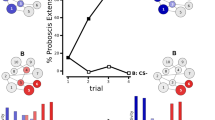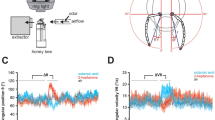Abstract
Honeybees fixed in small tubes scan an object within the range of the antennae by touching it briefly and frequently. In our experiments the animals were able to scan an object for several minutes with the antennae. After moving the object out of the range of the antennae, the animals showed antennal movements for several minutes that were correlated with the position of the removed object. These changes of antennal movements are called “behavioural plasticity” and are interpreted as a form of motor learning. Bees showed behavioural plasticity only for objects with relatively large surfaces. Plasticity was more pronounced in bees whose compound eyes were occluded. Behavioural plasticity was related to the duration of object presentation. Repeated presentations of the object increased the degree of plasticity. After presentation durations of 30 min the animals showed a significant increase of antennal positions related to the surface of the object and avoidance of areas corresponding to the edges. Behavioural plasticity was compared with reward-dependent learning by conditioning bees to objects. The results of motor learning and reward-dependent conditioning suggest that bees have tactile spatial memory.
Similar content being viewed by others
Author information
Authors and Affiliations
Additional information
Accepted: 13 May 1997
Rights and permissions
About this article
Cite this article
Erber, J., Pribbenow, B., Grandy, K. et al. Tactile motor learning in the antennal system of the honeybee (Apis mellifera L.). J Comp Physiol A 181, 355–365 (1997). https://doi.org/10.1007/s003590050121
Issue Date:
DOI: https://doi.org/10.1007/s003590050121




